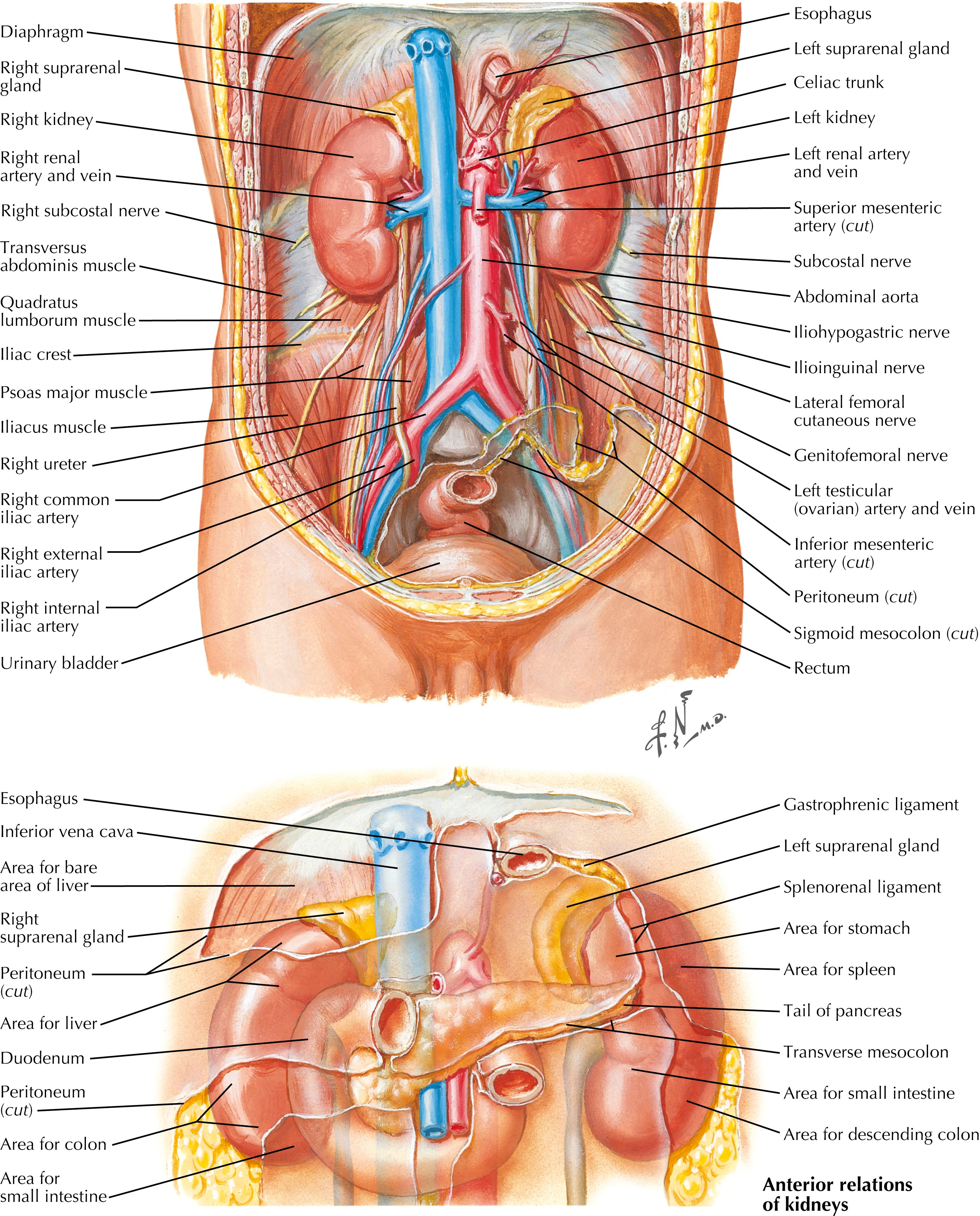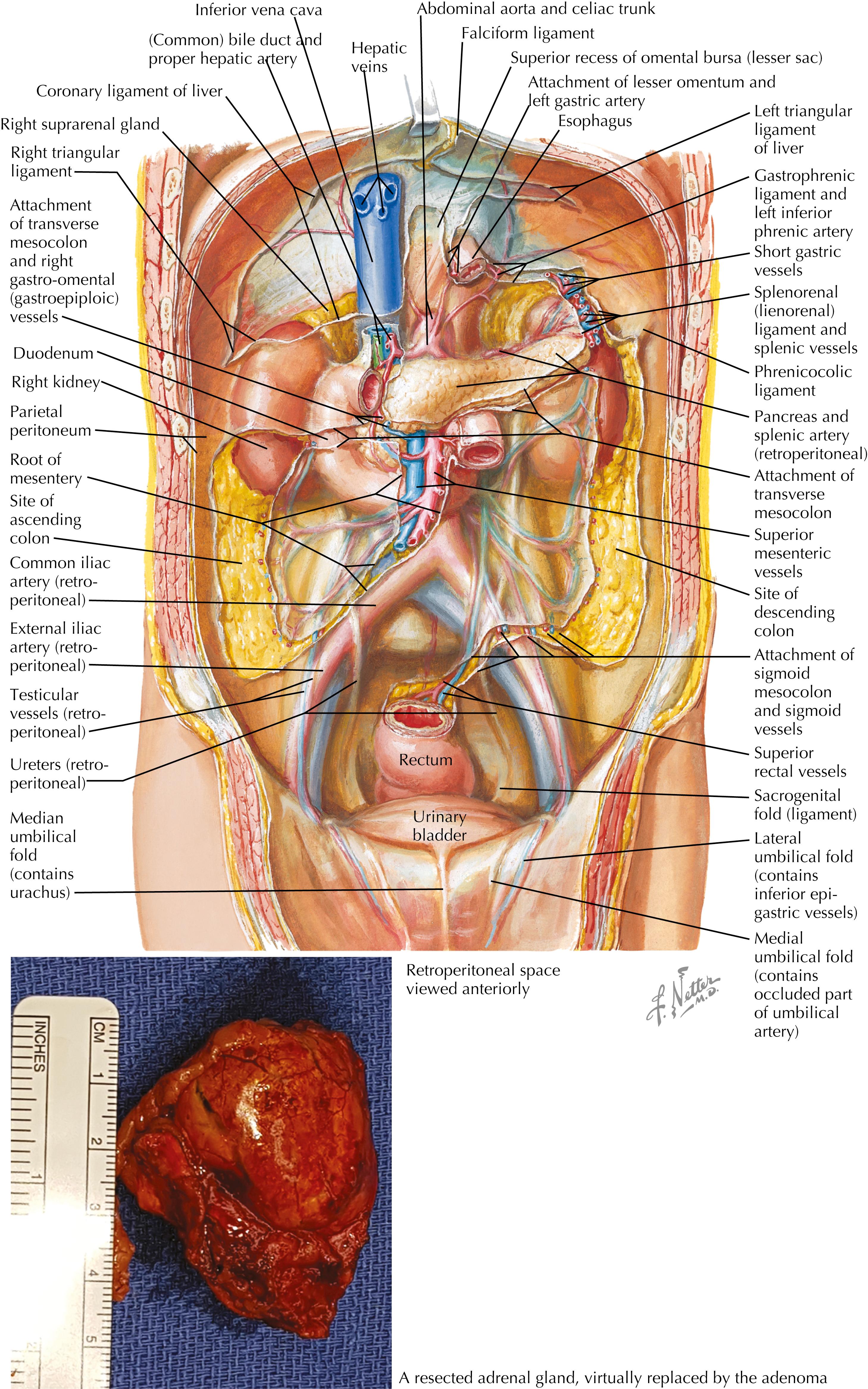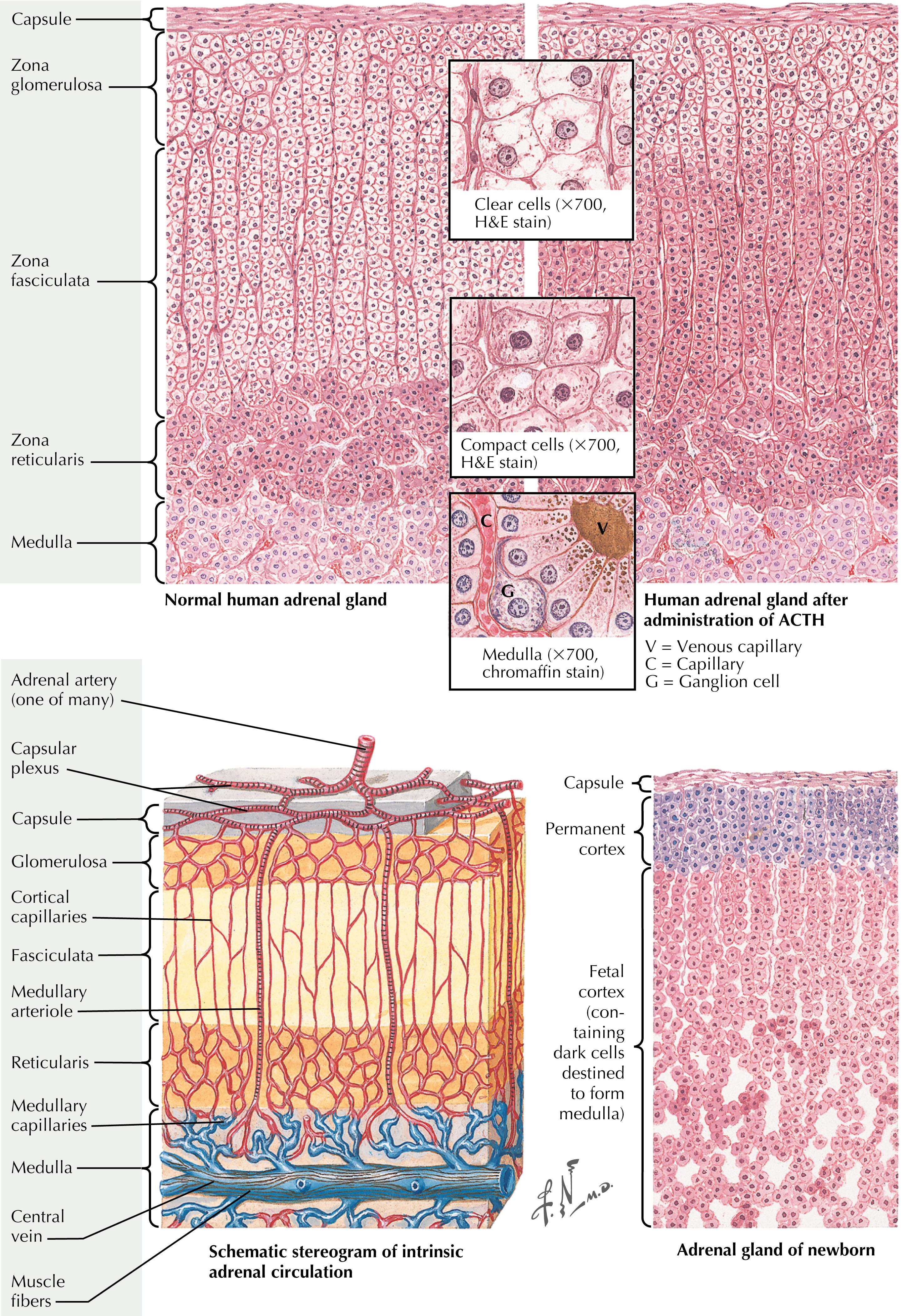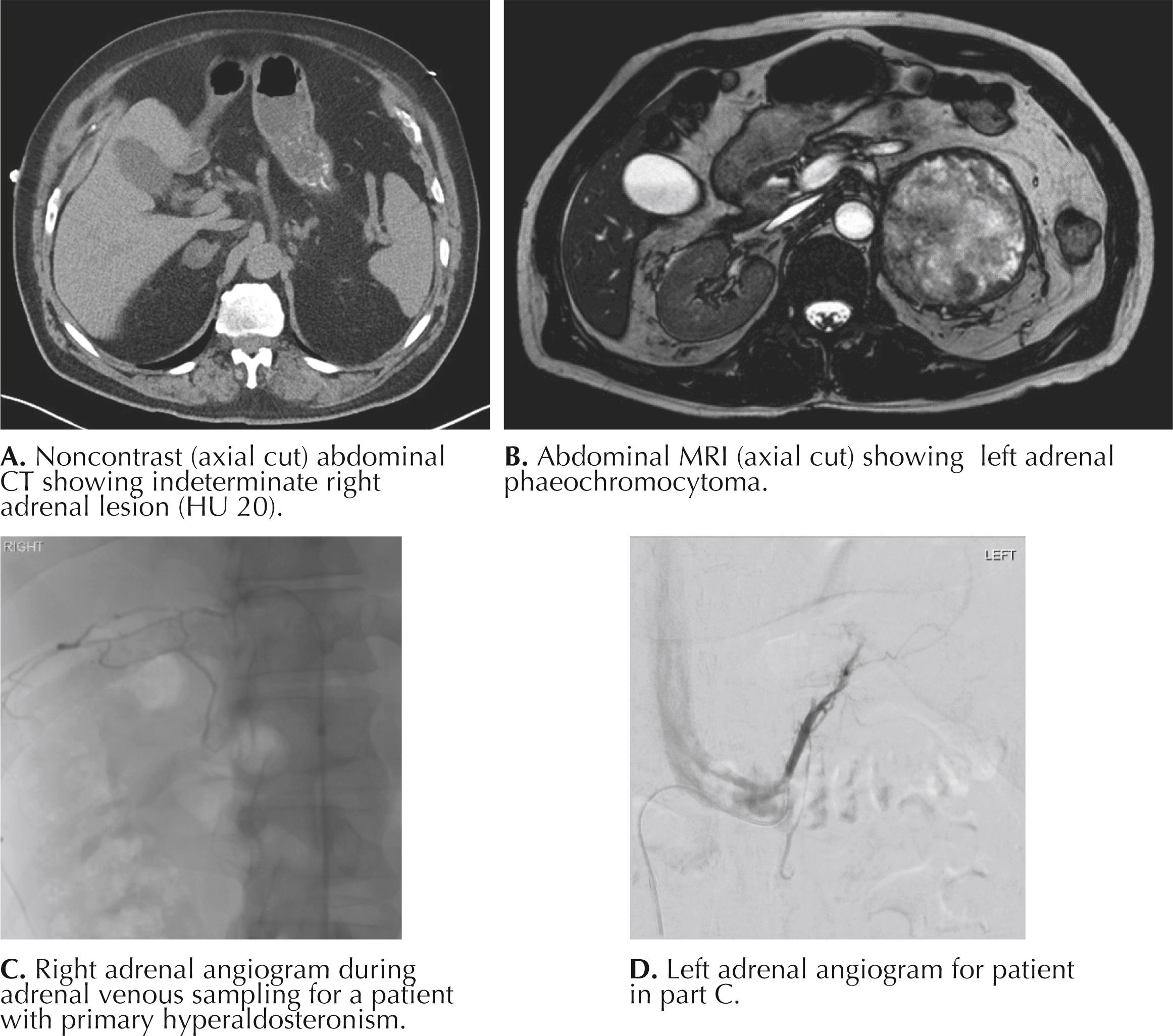Physical Address
304 North Cardinal St.
Dorchester Center, MA 02124
The adrenals are paired retroperitoneal glands that lie partially anterior, superior, and medial to the upper pole of the kidneys, bounded by retroperitoneal fat and Gerota’s fascia. The right adrenal gland is posteromedial to the right lobe of the liver and posterior to the inferior vena cava (IVC). The left adrenal gland is lateral to the aorta and posterior to the splenic artery and pancreatic tail ( Figs. 4.1 and 4.2 ). The most common morphologic configuration is an inverted V or Y-shape, with an anteromedial body and two posterolateral limbs. A normal adrenal gland is 2 to 6 mm thick and 2 to 4 cm in length ( Fig. 4.2 , inset ). Rarely small rests of adrenal tissue can be found near the adrenal bed or in the pelvis, which may be important in refractory cases.


The arterial supply is via the superior, middle, and inferior adrenal arteries, which branch from the inferior phrenic, abdominal aorta, and renal arteries, respectively. From a clinical perspective, the surgeon also encounters multiple, small, and unnamed branches. The venous drainage consists of one dominant vein that must be formally ligated and divided. The left adrenal vein often joins the medially located left inferior phrenic vein to form a common channel before entering the left renal vein. The right adrenal vein is short and drains directly into the posterolateral aspect of the IVC.
The adrenal gland is composed of a capsule, an outer cortex with three distinct functional layers (zona glomerulosa, zona fasciculata, zona reticularis), and an inner medulla ( Fig. 4.3 ). Each cortical sublayer and the medulla secrete specific hormones with individual functions.

Cross-sectional imaging via a noncontrast computed tomography (CT) or magnetic resonance imaging (MRI) is integral in the workup of adrenal nodules ( Fig. 4.4A and B ). A CT with adrenal protocol is a three-phase scan that includes a nonenhanced phase, a postcontrast portal venous phase (70 seconds after intravenous injection of iodinated contrast), and a delayed phase (15 minutes after injection). It is important to calculate the contrast washout characteristics of an adrenal lesion, especially for lipid-poor adenomas. The Hounsfield scale is a quantitative measure of radiodensity and is best determined on a noncontrast image. The radiodensity of distilled water at standard pressure and temperature is defined as zero Hounsfield units (HU). Adrenal masses with low (<10U) HU are considered benign.
MRI evaluation of adrenal lesions may also be useful, although typically less sensitive than CT. A normal adrenal gland appears hypointense (dark) on T1- and T2-weighted images, relative to surrounding soft tissue. MRI enables excellent morphologic delineation of adrenal masses but, similar to CT, cannot distinguish the cortex from the medulla and therefore cannot differentiate cortical tumors from medullary tumors, adenomas from phaechromocytomas. The role of positron emission tomography-computed tomography (PET-CT) imaging for adrenal disease is limited to patients with a prior history of cancer. False negatives may be seen with necrotic or hemorrhagic metastases and non-fluorodeoxyglucose (FDG) avid cancers (e.g., neuroendocrine tumors [NETs]). Adrenal venous sampling has become the gold-standard practice for lateralization in primary aldosteronism ( Fig. 4.4C and D ).

Not all adrenal lesions warrant removal. Adrenalectomy should be considered in three independent scenarios:
Functional tumors with hypersecretion of adrenal hormones
Potentially malignant (indeterminate) tumors: unequivocal growth on serial imaging 6 months apart or HU >10 on noncontrast CT scan
Malignant tumors
Biopsy may be considered in very rare situations to obtain a tissue diagnosis in patients with adrenal metastases before initiating systemic treatment.
Subtotal or cortical-sparing adrenalectomy may be considered in patients with bilateral adrenal tumors or a heredity associated with high risk of recurrence (e.g., Von Hippel Lindau [VHL]), obviating the incidence of iatrogenic adrenal insufficiency and its numerous sequelae. Where possible, it is preferable to perform subtotal resection on the left as it is often harder to re-operate on the right.
A minimally invasive approach has become the gold standard of care for adrenal surgery despite a paucity of RCTs comparing it with open surgery.
The location of the adrenals in the upper retroperitoneal space has led to the development of several surgical approaches: anterior transperitoneal, lateral transperitoneal, and posterior retroperitoneal. Each approach is associated with unique but important patient positioning to maximize exposure. When deciding the best approach for a patient, surgeons should consider body habitus, history of prior abdominal surgery, and tumor size and locality. Typically, lateral transabdominal adrenalectomy provides the widest operative field, and anatomic landmarks are most familiar. It is also easier to convert to an open approach in rare emergency settings and uses gravity for natural retraction of the liver/spleen. By contrast, the posterior retroperitoneal is advantageous for bilateral resections because it avoids the need to reposition and re-prep the patient. Relative contraindications to a retroperitoneal resection are tumors larger than 7 cm (difficult to create adequate working space), body mass index (BMI) exceeding 45 (difficult to create room on the operating table for the pannus), increased intraocular pressure (IOP; prone positioning increases IOP and, if prolonged, may cause optic nerve injury and blindness), and the need to explore the peritoneal cavity (e.g., to examine for metastatic disease).
Become a Clinical Tree membership for Full access and enjoy Unlimited articles
If you are a member. Log in here